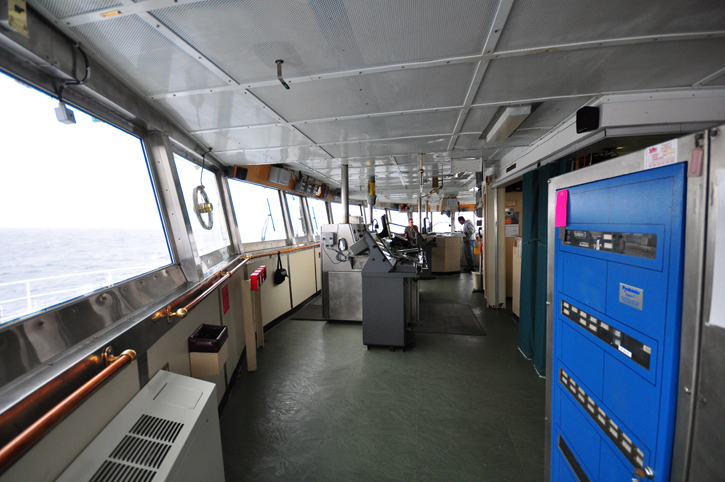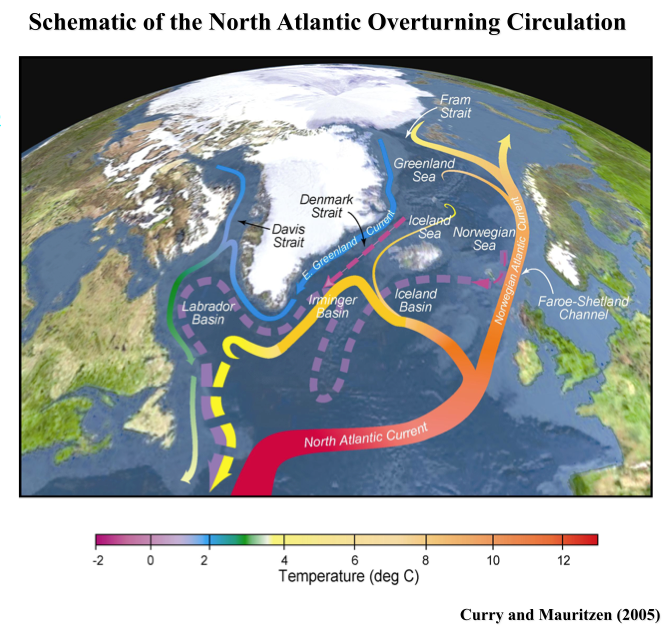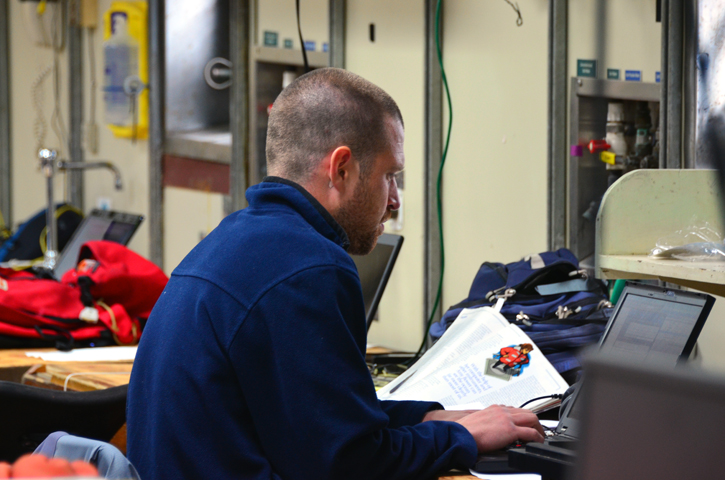August 22, 2011It’s only blowing 25 knots this morning from north-northeast, but the rumpled sea state suggests higher wind. That’s probably because there’s no land away in that direction, just ocean. The distance over which wind blows unimpeded by land is called fetch. Long fetch results in higher waves for the same wind velocity than shorter fetch. I was just up on the bridge listening to the nautical talk—I’ve missed it—and thinking about the difference between the mariner’s view of the ocean and the oceanographer’s.
Knorr’s bridge perches forty-five feet above the waterline. From that height of eye, says the Nautical Almanac, we can see a circle of water with a 7.8-mile radius before the Earth curves away. The bridge watch pays very close attention to that water, particularly the quadrant ahead. The average depth of the Atlantic is about 10,000 feet, but at sea where there’s no bottom to hit, mariners need only consider the surface of the sea to do their jobs successfully. To do his, the oceanographer needs to understand all of it. And like all Earth scientists, oceanographers understand their subject by measuring it. But how do you measure an ocean? We need to address that and another fundamental principle or two in order to appreciate the trajectory and the importance of this voyage. So let’s start with one fundamental principle: The ocean is never still, even when it appears to be. Waves are the most readily observable form of motion. And a kid on the beach can observe tidal motion when incoming water dissolves his once-high and dry sand castle. But that barely scratches the surface of ocean motion, if you don’t mind the pun. Dozens of currents course though the body of the world ocean. Some flow on the surface driven largely by global wind belts such as the trade winds and the prevailing westerlies in the mid-latitudes. Some surface currents are cold, some warm; some flow fast transporting lots of water in a relatively thin stream, while others are broad and sluggish. Other currents flow though the deep ocean, some in the intermediate depths, others along the bottom two or three miles down. Together, they’re called ocean currents, which let’s define as large quantities of a particular type of water moving permanently in a single direction. Ocean currents will wobble in velocity and wander in direction, but in the mean they always flow in one direction.
We’ll talk much more as the trip evolves about the climatic significance of ocean currents, but for now suffice it to say that they transport heat around the globe. When oceanographers say “heat,” they don’t mean “hot” exclusively. They mean the full range of temperature from hot to cold. In the Atlantic, for instance, ocean currents transport warm water from the tropics toward the Arctic, and other currents transport Arctic cold back toward the tropics. The result of this circular exchange is climatic moderation. So we can say that ocean currents (in collaboration with the atmosphere) make broad zones of the Earth that would otherwise be too hot or too cold congenial to a range of plant, animal, and human life. The oceanographer’s business is to measure ocean currents. But how? How do you measure an ocean?
Oceanographer Kjetil Våge at work. © Rachel Fletcher In most ways the ocean, rough and vast in three dimensions, defies our efforts to understand it. But in one respect it cooperates, indeed makes oceanography possible: Water masses—currents—have individual identities, fingerprints. Oceanographers can distinguish one water mass from its neighbor or from one a half a world away by measuring its temperature, salinity, and its velocity. That makes the job sound easy when it’s not. It’s difficult, arduous, and occasionally dangerous; plus, you get seasick. But it can be done. We’ll be doing it in places where it’s not been done before.
Last updated: December 27, 2011 | ||||||||||||
Copyright ©2007 Woods Hole Oceanographic Institution, All Rights Reserved, Privacy Policy. | ||||||||||||


 The bridge, where the crew drives the ship. © Rachel Fletcher.
The bridge, where the crew drives the ship. © Rachel Fletcher.

